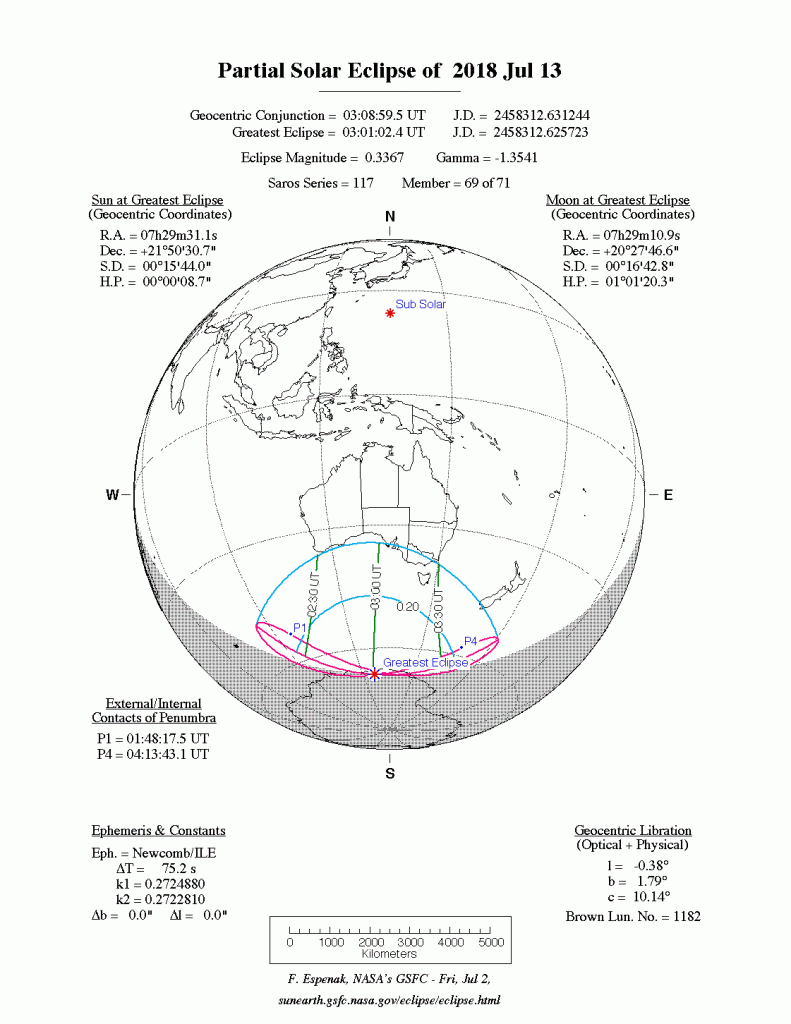
The new moon supermoon on July 13, 2018, takes a bite out of the sun’s disk, to stage the first Friday the 13th solar eclipse since December 13, 1974. We won’t have another Friday the 13th solar eclipse until September 13, 2080. All three of these Friday the 13th solar eclipses – in 1974, 2018 and 2080 – are partial.

A total eclipse of the sun will occur exactly 19 years after the solar eclipse on July 13, 2018. However, this total solar eclipse on July 13, 2037, will fall on a Monday, rather than a Friday. To the best of our knowledge, a total solar eclipse won’t happen on a Friday the 13th until Friday, June 13, 2132.
The Friday the 13th solar eclipse in July 2018 takes place mainly over the Southern Ocean area between Australia and Antarctica, as shown on the worldwide map and animation below. A very skimpy partial eclipse can be seen along the coastal areas of southeastern Australia during the afternoon hours on Friday, July 13, 2018. If you’re in a position to witness this eclipse, be sure to use proper eye protection.

We give eclipse times for our Australian friends in local time (so no time conversion is necessary).
Local eclipse times for Australia (2018 July 13)
Geelong, Victoria
Eclipse begins: 1:01 p.m. local time
Maximum eclipse: 1:20 p.m. local time
Eclipse ends: 1:40 p.m. Local time
Eclipse obscuration: 0.7% of the solar diskHobart, Tasmania
Eclipse begins: 12:52 p.m. Local time
Maximum eclipse: 1:25 p.m. local time
Eclipse ends: 1:56 p.m. local time
Eclipse obscuration: 3.5% of the solar diskLaunceston, Tasmania:
Eclipse begins: 12:56 p.m. local time
Greatest eclipse: 1:25 p.m. Local time
Eclipse ends: 1:53 p.m. local time
Eclipse obscuration: 2.4% of the solar diskMelbourne, Victoria
Eclipse begins: 1:05 p.m. local time
Greatest eclipse: 1:21 p.m. local time
Eclipse ends: 1:38 p.m. local time
Eclipse obscuration: 0.4% of the solar diskSource: EclipseWise and Observer’s Handbook
Eclipse calculators
If you live in the eclipse viewing area, and your locality is not listed above, go to TimeandDate or EclipseWise to find out the local eclipse times for where you live.
This interactive Google eclipse map enables the user to scroll anywhere within the eclipse viewing area to know when the eclipse begins, reaches greatest eclipse and then ends in Coordinated Universal Time (UTC). You must convert Coordinated Universal Time (UTC) to local time. Here’s how.
In Victoria and Tasmania, Australia, your local time = UTC + 10 hours

Eclipses and eclipse seasons
A solar eclipse always happens within approximately two weeks of a lunar eclipse. The partial solar eclipse on July 13, 2018, will be followed by the longest total lunar eclipse of the 21st century (2001 to 2100) on July 27, 2018. Then one fortnight after the total eclipse of the moon on July 27, 2018, there will be another partial solar eclipse on August 11, 2018.
Usually, eclipses only come in pairs, with one solar eclipse and one lunar eclipse taking place in one eclipse season, a period of time lasting somewhat longer than one calendar month. The mid-point of this particular eclipse season comes on July 28, 2018, and eclipse seasons recur in periods of about 173 days (somewhat shy of six calendar months).
One lunar month (the period of time between successive new moons) lasts about 29.5 days. So if the new moon comes early enough in the approximate 34-day eclipse season, then there will be enough time for one new moon, one full moon and a second new moon in one eclipse season. That’s exactly what happens during this eclipse season:
2018 July 13: partial solar eclipse
2018 July 27: total lunar eclipse
2018 August 11: partial solar eclipse
Any eclipse occurring near the beginning or ending of an eclipse season always displays a skimpy partial eclipse whereas any eclipse falling near the middle of an eclipse season always presents a total eclipse. Therefore, the partial eclipse of the sun on July 13, 2018, will be followed by a total lunar eclipse on July 27, 2018, and then a partial eclipse of the sun on August 11, 2018.
Bottom line: The moon’s dark umbra totally misses Earth this time around, but the penumbra clips the southern portion of the globe on July 13, 2018, to feature a rather skimpy partial eclipse of the sun over the Antarctic Ocean region to the south of Australia.











